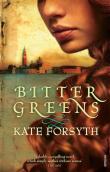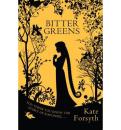AustLit
Latest Issues
AbstractHistoryArchive Description
'Charlotte-Rose de la Force has been banished from court by the Sun King, Louis XIV, after a series of scandalous love affairs. She is comforted by an old nun, Sœur Seraphina, who tells her the tale of a young girl who, a hundred years earlier, is sold by her parents for a handful of Bitter Greens ...
'After Margherita's father steals a handful of greens - parsley, wintercress and rapunzel - from the walled garden of the courtesan, Selena Leonelli, they give up their daughter to save him from having both hands cut off. Selena is the famous red-haired muse of the artist Tiziano, first painted by him in 1513 and still inspiring him at the time of his death, sixty-one years later. Called La Strega Bella, Selena is at the centre of Renaissance life in Venice, a world of beauty and danger, seduction and betrayal, love and superstition.
'Locked away in a tower, growing to womanhood, Margherita sings in the hope someone will hear her. One day, a young man does ...
'Three women, three lives, three stories, braided together to create a compelling story of desire, obsession, black magic, and the redemptive power of love.' (From the publisher's website.)
Notes
-
Inspired by the fairy tale Rapunzel.
-
Dedication:
This book is dedicated to all my dear friends who are
both women and writers - we are living the life that Charlotte-Rose dreamt of.
Publication Details of Only Known VersionEarliest 2 Known Versions of
Other Formats
- Also sound recording.
- Also large print.
Works about this Work
-
'A Crowd at Your Back' : Fantasy Fandom and Small Press
2019
single work
criticism
— Appears in: Media International Australia , February vol. 170 no. 1 2019; (p. 115-125) 'This article presents a study of a model of textual production that situates genre fiction, specifically fantasy fiction, within its community and industry contexts. I argue that Australian fantasy ‘fandom’ operates in some ways like a research and development space for the literature it consumes, through allowing, enabling and enthusiastically supporting – both ethically and materially – a thriving small press culture. Fandom is known for its passionate investments in texts, and those investments are rarely passive. The fantasy genre community is already oriented towards prosumption, and small presses afford specific opportunities for writers to work in specific ways, enriching and developing their individual craft and the genre as a whole.' (Publication abstract) -
Strategic, Stylistic and Notional Intertextuality : Fairy Tales in Contemporary Australian Fiction
2018
single work
criticism
— Appears in: TEXT Special Issue Website Series , no. 43 2018;'While Canadian scholar Lisa M Fiander argues that fairy tales are ‘everywhere’ in Australian fiction, this paper questions that assertion. It considers what it means for a fairy tale to be ‘in’ a work of contemporary fiction, and posits a classificatory system based on the vocabulary of contemporary music scholarship where a distinction is made between intertextuality that is stylistic and that which is strategic. Stylistic intertextuality is the adoption of features of a style or genre without reference to specific examples, while strategic intertexuality references specific prior works.
'Two distinct approaches to strategic fairy-tale revision have emerged in Australian writing in recent decades. One approach, exemplified in works by writers including Kate Forsyth, Margo Lanagan and Juliet Marillier, leans towards the retelling of European fairy tales. Examples include Forsyth’s The Beast’s garden (‘Beauty and the Beast’), Lanagan’s Tender morsels (‘Snow White and Rose Red’) and Marillier’s short story ‘By bone-light’ (‘Vasilisa the Beautiful’). The other, more fractured, approach is exemplified in works by writers including Carmel Bird and Murray Bail, which do not retell fairy tales but instead echo them and allude to them.
'This paper proposes that recent Australian works that retell fairy tales are less likely to be set in a recognisably Australian context than are works which take a more fractured approach to fairy tale. It also explores the notion that, presently, transporting European fairy tales, whole, into an Australian setting, seems to be a troubling proposition for writers in a post-colonial settler society that is highly sensitised to, but still largely in denial about, its colonial past.' (Publication abstract)
-
Retelling Rapunzel
2018
single work
essay
— Appears in: TEXT Special Issue Website Series , no. 43 2018;'This article explores Australian author Kate Forsyth’s obsession with ‘Rapunzel’, from the time she first read the fairy tale as a child in hospital through to her doctoral research into the history of the ‘Maiden in the Tower’ and her creative responses to the story as expressed in her novel Bitter greens and her poem ‘In the tower’.' (Publication abstract)
-
A Grimm Tale
2013
single work
column
— Appears in: The Sydney Morning Herald , 21 February 2013; (p. 7) 'A fascination with the true story behind Rapunzel proved fertile ground for Australian author Kate Forsyth...' -
Book Review – Bitter Greens by Kate Forsyth
2012
single work
review
— Appears in: Booklover Book Reviews 2012;
— Review of Bitter Greens 2012 single work novel
-
[Review] Bitter Greens
2012
single work
review
— Appears in: Bookseller + Publisher Magazine , February/March vol. 91 no. 7 2012; (p. 29)
— Review of Bitter Greens 2012 single work novel -
Rapunzel's Tale Retold
2012
single work
review
— Appears in: The Canberra Times , 31 March 2012; (p. 26)
— Review of Bitter Greens 2012 single work novel -
[Review] Bitter Greens
2012
single work
review
— Appears in: The Courier-Mail , 21-22 April 2012; (p. 22)
— Review of Bitter Greens 2012 single work novel -
Lady, Let Your Hair Down
2012
single work
review
— Appears in: The Sydney Morning Herald , 26-27 May 2012; (p. 34)
— Review of Bitter Greens 2012 single work novel -
Off the Shelf : Fiction
2012
single work
review
— Appears in: The Saturday Age , 16 June 2012; (p. 34)
— Review of Bitter Greens 2012 single work novel -
Feminism and Fairytales
Bec Kavanagh
(interviewer),
2012
single work
interview
— Appears in: Bookseller + Publisher Magazine , February/March vol. 91 no. 7 2012; (p. 39) -
A Grimm Tale
2013
single work
column
— Appears in: The Sydney Morning Herald , 21 February 2013; (p. 7) 'A fascination with the true story behind Rapunzel proved fertile ground for Australian author Kate Forsyth...' -
Retelling Rapunzel
2018
single work
essay
— Appears in: TEXT Special Issue Website Series , no. 43 2018;'This article explores Australian author Kate Forsyth’s obsession with ‘Rapunzel’, from the time she first read the fairy tale as a child in hospital through to her doctoral research into the history of the ‘Maiden in the Tower’ and her creative responses to the story as expressed in her novel Bitter greens and her poem ‘In the tower’.' (Publication abstract)
-
Strategic, Stylistic and Notional Intertextuality : Fairy Tales in Contemporary Australian Fiction
2018
single work
criticism
— Appears in: TEXT Special Issue Website Series , no. 43 2018;'While Canadian scholar Lisa M Fiander argues that fairy tales are ‘everywhere’ in Australian fiction, this paper questions that assertion. It considers what it means for a fairy tale to be ‘in’ a work of contemporary fiction, and posits a classificatory system based on the vocabulary of contemporary music scholarship where a distinction is made between intertextuality that is stylistic and that which is strategic. Stylistic intertextuality is the adoption of features of a style or genre without reference to specific examples, while strategic intertexuality references specific prior works.
'Two distinct approaches to strategic fairy-tale revision have emerged in Australian writing in recent decades. One approach, exemplified in works by writers including Kate Forsyth, Margo Lanagan and Juliet Marillier, leans towards the retelling of European fairy tales. Examples include Forsyth’s The Beast’s garden (‘Beauty and the Beast’), Lanagan’s Tender morsels (‘Snow White and Rose Red’) and Marillier’s short story ‘By bone-light’ (‘Vasilisa the Beautiful’). The other, more fractured, approach is exemplified in works by writers including Carmel Bird and Murray Bail, which do not retell fairy tales but instead echo them and allude to them.
'This paper proposes that recent Australian works that retell fairy tales are less likely to be set in a recognisably Australian context than are works which take a more fractured approach to fairy tale. It also explores the notion that, presently, transporting European fairy tales, whole, into an Australian setting, seems to be a troubling proposition for writers in a post-colonial settler society that is highly sensitised to, but still largely in denial about, its colonial past.' (Publication abstract)
-
'A Crowd at Your Back' : Fantasy Fandom and Small Press
2019
single work
criticism
— Appears in: Media International Australia , February vol. 170 no. 1 2019; (p. 115-125) 'This article presents a study of a model of textual production that situates genre fiction, specifically fantasy fiction, within its community and industry contexts. I argue that Australian fantasy ‘fandom’ operates in some ways like a research and development space for the literature it consumes, through allowing, enabling and enthusiastically supporting – both ethically and materially – a thriving small press culture. Fandom is known for its passionate investments in texts, and those investments are rarely passive. The fantasy genre community is already oriented towards prosumption, and small presses afford specific opportunities for writers to work in specific ways, enriching and developing their individual craft and the genre as a whole.' (Publication abstract)
Awards
- 2013 Norma K. Hemming Award Honourable mention
- 2013 shortlisted Ditmar Awards — Best Novel
- 2012 shortlisted Aurealis Awards for Excellence in Australian Speculative Fiction — Fantasy Division — Best Novel
-
cFrance,cWestern Europe, Europe,
-
cItaly,cWestern Europe, Europe,
- 1500-1599
- 1600-1699







